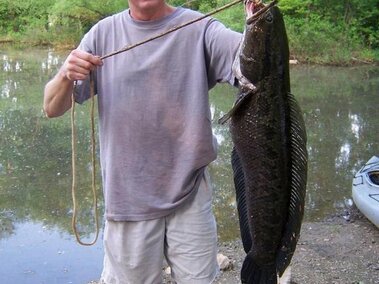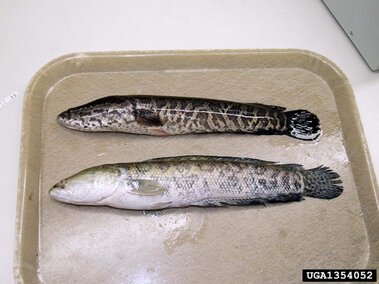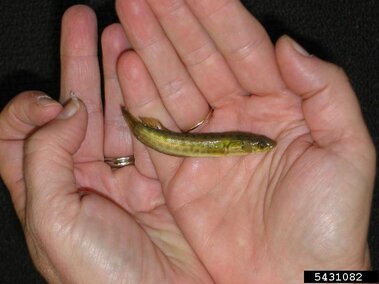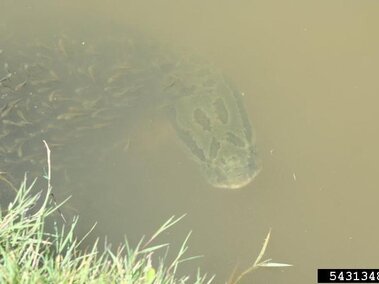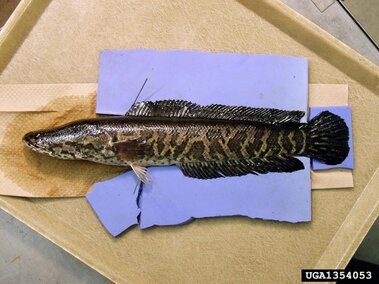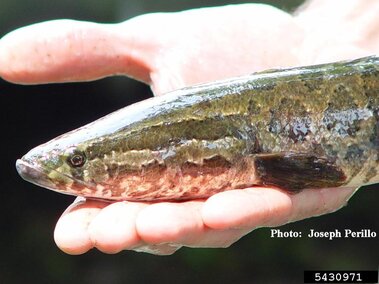Credit: Sam Stukel/USFWS, Public Domain
General Information
Species Name: Channa argus
Also Known As: northern snakehead, eastern snakehead, ocellated snakehead, amur snakehead
Family: Channidae (Snakehead)
Life Span: 10-15 years
Life Cycle: They are capable of breeding up to five times a year, the females releasing some 50,000 eggs each time. They build a nest by clearing the plants out of a column of water about 2–3 feet in diameter. The adults stay with the nest and young for up to a month and vigorously protect them, increasing the survival rate of their offspring. The young grow quickly, so they rapidly attain a size which prevents them from being eaten by other predators, including herons and eagles. They can begin breeding at age 2 or 3.
Origin: Asia
Injurious: Yes. Currently under the Lacey Act, snakehead are listed as injurious wildlife by the U.S. Fish and Wildlife Service, which prohibits the importation into or transportation between the continental United States, the District of Columbia, Hawaii, the Commonwealth of Puerto Rico or any territory or possession of the United States of live snakehead, gametes, viable eggs and hybrids.
Category 1: Potential Aquatic Invasive Species
Why Are They Invasive?
Snakehead juveniles feed on a wide variety of microscopic organisms, insect larvae, and crustaceans on which native fish rely. As adults, they feed mostly on other fish species, but also eat crustaceans, reptiles, mammals and small birds. Snakeheads have the potential to reduce or even eliminate native fish populations and alter aquatic communities. Municipalities which rely on tourist dollars from recreational fishing may suffer losses should snakeheads continue to invade their waters.
What Do They Look Like?
Snakeheads are long, thin fish with a single fin running the length of the back. They are generally brown with large, dark blotches along their sides and can grow up to three feet long. They have a somewhat flattened head and a large mouth with many sharp teeth. Northern snakeheads are very similar to bowfin (Amia calva), which can most easily be distinguished from snakeheads by a shorter anal fin and a rounded tail fin.
Photos
Where Do They Live?
The favored habitat for the northern snakehead is in shallow, stagnant water with muddy substrates and somewhat dense aquatic vegetation. This fish also occurs in slow-moving, muddy streams, both large and small, drainage ditches, rivers, ponds, reservoirs, and lakes. Snakeheads can survive the cold winters and low oxygen environment. Some snakeheads are capable of breathing atmospheric oxygen and may be able to jump out of the water to be found on terrestrial land near aquatic systems. They are established in Virginia, Maryland, Pennsylvania, New York and Arkansas. Individual fish have also been collected in California, Florida, Illinois, Massachusetts, Delaware and North Carolina. In 2024, several snakeheads were caught by anglers below Wappapello Lake Spillway in Wayne County, MO.
How Do They Spread?
It is believed that the northern snakehead fish entered the United States when aquarium owners discarded their unwanted exotic captive species into local waterways. The fish is also an important food source in other countries and could have been intentionally released into waterways to create a local food source for fisherman here in the United States. Even though it is illegal in some states to possess a snakehead fish, they are utilized in some restaurants and are available for purchase online.
How Do I Control Them?
Contact the Nebraska Game and Parks Commission to determine appropriate control methods. To prevent their spread and introduction into your waterbodies:
CLEAN your watercraft, trailer, angling gear and other equipment. Remove all aquatic vegetation and animal species from your equipment.
DRAIN your watercraft at the ramp by removing the boat plug and draining all live wells and ballast tanks.
DRY your watercraft, trailer and other equipment for at least 7 days before visiting another waterbody.
DON'T DUMP BAIT. Dispose of bait by emptying bait buckets on dry land, away from waterbodies or in a trash receptacle. Moving a live organism from one waterbody to another is illegal, even if you are planning to use the organism as bait.
DON'T LET IT LOOSE. Do not release or transport exotic or non-native fish species to new ecosystems. It is unlawful to release any aquatic species into a waterbody other than the one from which it was harvested. Doing so can promote the spread of AIS.
What Should I Do If I See Them in Nebraska?
If you see snakehead in Nebraska, you should report them to the Nebraska Game and Parks Commission's Aquatic Invasive Species (AIS) Program using their AIS Report Form. For guidance on what information to include in your report, check out our reporting tips. If you catch a snakehead fish, do not release it back into the water. Kill it, freeze it in a double bag and then report the fish and its location to the Nebraska Game and Park Commission's Aquatic Invasive Species (AIS) Program for documentation.
References and More Information
Center for Invasive Species and Ecosystem Health
Missouri Department of Conservation
Hartwig, J. (2024). MDC confirms fourth invasive northern snakehead captured in Missouri. Missouri Department of Conservation.
Nebraska Game and Parks Commission
New York Invasive Species Information


